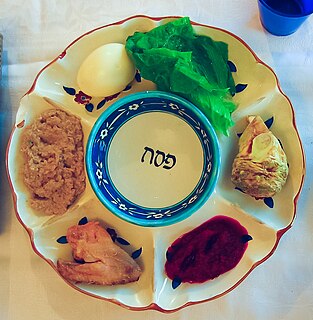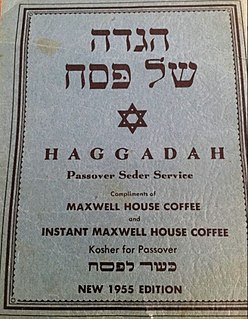Related Research Articles

Passover or Pesach is a major Jewish holiday and one of the most widely celebrated Jewish holidays. Together with Shavuot and Sukkot, Passover was one of the Three Pilgrimage Festivals during which the entire population of the kingdom of Judah made a pilgrimage to the Temple in Jerusalem. Samaritans still make this pilgrimage to Mount Gerizim, but only men participate in public worship.

The Passover Seder is a Jewish ritual feast that marks the beginning of the Jewish holiday of Passover. It is conducted throughout the world on the evening of the 14th day of Nisan in the Hebrew calendar. The day falls in late March or in April of the Gregorian calendar and the Passover lasts for 7 days in Israel and 8 days outside Israel. Jews generally observe one or two seders: in Israel, one seder is observed on the first night of Passover; many Diaspora communities hold a seder also on the second night. The Seder is a ritual performed by a community or by multiple generations of a family, involving a retelling of the story of the liberation of the Israelites from slavery in ancient Egypt. This story is in the Book of Exodus (Shemot) in The Hebrew Bible. The Seder itself is based on the Biblical verse commanding Jews to retell the story of the Exodus from Egypt: "You shall tell your child on that day, saying, 'It is because of what the LORD did for me when I came out of Egypt.'" Traditionally, families and friends gather in the evening to read the text of the Haggadah, an ancient work derived from the Mishnah. The Haggadah contains the narrative of the Israelite exodus from Egypt, special blessings and rituals, commentaries from the Talmud, and special Passover songs.

The Haggadah is a Jewish text that sets forth the order of the Passover Seder. Reading the Haggadah at the Seder table is a fulfillment of the mitzvah to each Jew to "tell your son" of the Jewish liberation from slavery in Egypt as described in the Book of Exodus in the Torah.

The Sarajevo Haggadah is an illuminated manuscript that contains the illustrated traditional text of the Passover Haggadah which accompanies the Passover Seder. It is one of the oldest Sephardic Haggadahs in the world, originating in Barcelona around 1350. The Haggadah is owned by the National Museum of Bosnia and Herzegovina in Sarajevo. Its monetary value is undetermined, but a museum in Spain required that it be insured for $7 million before it could be transported to an exhibition there in 1992.

Dayenu is a song that is part of the Jewish holiday of Passover. The word "dayenu" means approximately "it would have been enough", "it would have been sufficient", or "it would have sufficed". This traditional up-beat Passover song is over one thousand years old. The earliest full text of the song occurs in the first medieval haggadah, which is part of the ninth-century Seder Rav Amram. The song is about being grateful to God for all of the gifts he gave the Jewish people, such as taking them out of slavery, giving them the Torah and Shabbat, and had God only given one of the gifts, it would have still been enough. This is to show much greater appreciation for all of them as a whole. The song appears in the haggadah after the telling of the story of the exodus and just before the explanation of Passover, matzah, and the maror.

The Passover Seder plate is a special plate containing symbolic foods eaten or displayed at the Passover Seder.

Maror or Marror refers to the bitter herbs eaten at the Passover Seder in keeping with the biblical commandment "with bitter herbs they shall eat it.".
Chad GadyaorHad Gadya is a playful cumulative song in Aramaic and Hebrew. It is sung at the end of the Passover Seder, the Jewish ritual feast that marks the beginning of the Jewish holiday of Passover. The melody may have its roots in Medieval German folk music. It first appeared in a Haggadah printed in Prague in 1590, which makes it the most recent inclusion in the traditional Passover seder liturgy.
Uh! Oh! is an Israeli series of children's picture books about Jewish festivals published by Simcha Media Group (Hebrew) and Yellow Brick Road Publishers Inc (English). On each page, readers search for four items that provide information about each festival. The books contain facts, songs, and religious texts, as well as games, comics and drawings. The series is written and illustrated by various authors.

Ma Nishtana, are the first two words in a phrase meaning "Why is tonight different from all other nights?" The phrase appears at the beginning of each line of The Four Questions, traditionally asked via song by the youngest capable child attending Passover Seder.
Nishmat is a Jewish prayer that is recited following the Song of the Sea during Pesukei D'Zimrah but before Yishtabach on Shabbat and Yom Tov. It is also recited during the Passover seder in some traditions. It is prized by halakhic authorities because the concepts covered in this prayer are basic to halakha.

Jewish ceremonial art, also known as Judaica, refers to an array of objects used by Jews for ritual purposes. Because enhancing a mitzvah by performing it with an especially beautiful object is considered a praiseworthy way of honoring God's commandments, Judaism has a long tradition of commissioning ritual objects from craftsmen and artists.
Susannah Heschel is an American scholar and Eli Black professor of Jewish Studies at Dartmouth College. The author and editor of numerous books and articles, she is a Guggenheim Fellow and the recipient of numerous awards, including four honorary doctorates. Heschel's scholarship focuses on Jewish and Christian interactions in Germany during the nineteenth and twentieth centuries. She is the daughter of Abraham Joshua Heschel.
Ma'yan is a non-profit organization supporting research, education, and advocacy with and on behalf of adolescent girls. Ma'yan is housed in the JCC in Manhattan.

The White House Passover Seder was an annual private dinner held at the White House on the Jewish holiday of Passover during the presidency of Barack Obama. Obama initiated it in 2009 for his family, staff members, friends, and their families. The gathering recited the Passover Haggadah, discussed the themes of the Passover Seder and their relation to current events, and partook of a holiday-themed meal. Obama hosted and attended the Seder each year from 2009 to 2016. It was the first Passover Seder to be conducted by a sitting U.S. president in the White House.

Matzah pizza is a type of pizza made by baking a piece of matzo that has been topped with sauce and cheese. Because Jews are forbidden from eating leavened bread during Passover, some individuals use matzo as a substitute for traditional pizza crusts during the holiday.

Ha Lachma Anya is a declaration that is recited at the beginning of the Magid portion of the Passover Seder. Written in Aramaic, the recitation serves as the first explanation of the purpose of the matzo during the Seder.

The Maxwell House Haggadah is an English-Hebrew Passover Haggadah introduced by the Maxwell House company as a marketing promotion in 1932 and printed continuously since that time. With over 50 million copies in print, it is the best known and most popular Haggadah among American Jews, and is considered a cultural icon. It is used at Passover Seders in homes, schools, senior centers, prisons, and the United States Army, and was the edition used by President Obama and his guests at the White House Passover Seder conducted yearly from 2009 to 2016. In 2011 a new English translation replaced archaic phrases in the original and also incorporated gender-neutral language.

American Jewish cuisine comprises the food, cooking, and dining customs associated with American Jews. It was heavily influenced by the cuisine of Jewish immigrants who came to the United States from Eastern Europe around the turn of the 20th century. It was further developed in unique ways by the immigrants and their descendants, especially in New York City and other large metropolitan areas of the northeastern U.S.

The Birds' Head Haggadah is the oldest surviving illuminated Ashkenazi Passover Haggadah. The manuscript, produced in the Upper Rhine region of Southern Germany in the early 14th century, contains the full Hebrew text of the Haggadah, a ritual text recounting the story of Passover – the liberation of the Israelites from slavery in ancient Egypt – which is recited by participants at a Passover Seder. The text is executed in block calligraphy and accompanied by colorful illustrations of Jews performing the Seder practices and reenacting Jewish historical events. The Birds' Head Haggadah is so called because all Jewish men, women, and children depicted in the manuscript have human bodies with the faces and beaks of birds. Non-Jewish and non-human faces are blank or blurred. Numerous theories have been advanced to explain the unusual iconography, usually tied to Jewish aniconism. The Haggadah is in the possession of the Israel Museum in Jerusalem, where it is on permanent exhibition.
References
- ↑ Katie Shapiro (March 25, 2016), "Your new Passover tradition: How to elevate Seder dinner with cannabis: Get tips on the best ways to add the ancient herb into a modern celebration. Oregon couple Roy and Claire Kaufmann are looking to inspire their fellow 'high-minded Jews'", The Cannabist, The Denver Post
- ↑ Rebecca Spence (February 9, 2015), Le'Or aims to put marijuana legalization on the Jewish agenda, Jewish Telegraphic Agency
- ↑ Leslie Katz (April 20, 2016), Pot-themed Passover haggadah lights up new kind of bitter herb: Pass the bud for Passover. A new cannabis-themed edition of the Jewish text focuses on 420, but its creators say the point isn't about just getting high., CNET
- ↑ Alix Wall (April 15, 2016), "Cannabis seder changes definition of greens on plate", J. The Jewish News of Northern California